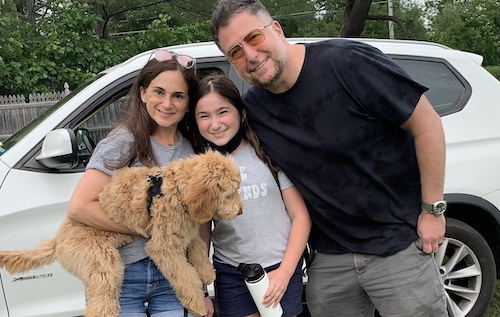 |
| Bob Brody |
In July of 2005, Shari Kurzrok was leading the happiest of lives. The 31-year-old New Yorker, a native of Great Neck, was planning her marriage to the love of her life. Everyone who knew her liked her for her kindness and compassion. She had recently spearheaded publicity for the nation's largest-ever blood drive, an American Red Cross initiative called the Save-A-Life Tour.
But it turned out that Shari's own life would need to be saved, too. One day, for no apparent reason at the time, the otherwise healthy public relations executive collapsed at home. An ambulance rushed her to a hospital. Doctors determined that her liver was failing. Her wedding might have to be postponed. She was designated Status 1, the highest risk category: she would have to get a liver transplant or she could die within a week.
Shari was admitted into an Intensive Care Unit to wait for a miracle.
 |
| Shari, Alexis, Robby and dog Teddy |
Luckily, her colleagues at Ogilvy Public Relations—chiefly Kym White, Kate Cronin and Jane Mazur—quickly banded together to try to help her. They created a website about her, opened a hotline and issued a press release calling for a liver donor. Family and friends joined the push to promote her plight, too. "I urge the public to help Shari the way she helped so many people," an American Red Cross spokesperson said.
She drifted in and out of consciousness as doctors kept her alive for the next three weeks. Plasma exchanges and dialysis treatments siphoned the toxins from her blood. All the while, Shari had no idea what was going on, neither that she was dying nor that anyone was trying to save her life. But then her brain started to swell, a symptom of the cerebral edema that typically kills patients with acute liver failure.
I knew Shari as a colleague. Her reputation as a dear soul and model citizen was well deserved. And I got the opportunity to play a cameo role in this PR blitz. I emailed my media contacts with the subject line "Please help my colleague Shari: she needs a liver transplant." I also acted as her media spokesperson. Extensive press coverage ensued locally and nationally.
In early August, a liver became available. And on a Saturday night, a dozen specialists at NYU Medical Center replaced her diseased liver with the donor organ. The lead physician, Dr. Lewis Tepperman, said Shari had received the transplant "in the nick of time."
As she recovered in the hospital, she resolved to turn her personal crisis into a public crusade. Back then, 89,000 people in the U.S. desperately needed a kidney or liver transplant (today, more than 106,803 American adults and children are on the national transplant waiting list, according to the federal Human Resources and Services Administration). She established a foundation to educate the public about the importance of organ donation.
That October, Shari got married, at the Woodbury Jewish Center, in a memorably dramatic wedding ceremony. Dr. Tepperman was a guest of honor (he is now vice-chair of surgery at North Shore University Hospital, which in 2019 performed Long Island's first liver transplant). A local newspaper dubbed Shari "the miracle bride."
Soon Shari wanted a child. Physicians assured her that she could have a healthy baby without passing along Wilson's Disease, the rare genetic disorder eventually diagnosed as the culprit. She became pregnant and delivered a baby girl, Alexis. Her middle name, "Nadia," in Russian means "hope," a choice made to honor the donor.
Shari is still at the agency after 18 years, still going full-tilt. She still serves as an advocate for the cause of organ donation, volunteering for LiveOnNY, a local organ procurement organization. In 2017, about 8,000 liver transplants were performed in the U.S. among both adults and children, with 450 in New York, according to the Mayo Clinic. An estimated 1,100 patients across New York State are currently awaiting a liver transplant. Every day 17 people nationwide in need of an organ transplant die waiting for one.
Last month, Shari and her husband Robby celebrated 16 years of marriage. Alexis just entered the fifth grade. "I'm grateful every day to everyone who helped me," she recently told me.
The Save-A-Life Tour she promoted dispatched convoys on a public health mission to 345 cities around the U.S. The campaign ultimately attracted more than 38,000 new potential donors and collected 3.2 million pints of blood. How many lives the American Red Cross saved as a result is impossible to quantify.
I'm now old enough to recognize how privileged I was to participate in that workplace drama back then, with the spirit of camaraderie so amply demonstrated in the service of a cause. I see, too, how Shari embodies the concept that what goes around comes around, that if you do good for others, good will come to you, too.
Talk about virtuous cycles and reaping what we sow. Thanks to her expertise and empathy, her efforts once gave strangers in need a second chance. No wonder a stranger then gave her a second chance, too.
***
Bob Brody, a public relations consultant and essayist, is a veteran of Weber Shandwick, Ogilvy and Rubenstein Associates. He is author of the memoir "Playing Catch with Strangers: A Family Guy (Reluctantly) Comes of Age."


 The techniques deployed by OJ Simpson's defense team in the "trial of the century" served as a harbinger for those used by Donald Trump... People worry about the politicization of medical science just as much as they fret about another pandemic, according to Edelman Trust Barometer... Book bans aren't restricted to red states as deep blue Illinois, Connecticut and Maryland challenged at least 100 titles in 2023.
The techniques deployed by OJ Simpson's defense team in the "trial of the century" served as a harbinger for those used by Donald Trump... People worry about the politicization of medical science just as much as they fret about another pandemic, according to Edelman Trust Barometer... Book bans aren't restricted to red states as deep blue Illinois, Connecticut and Maryland challenged at least 100 titles in 2023. The NBA, which promotes legalized gambling 24/7, seems more than hypocritical for banning player for placing bets... Diocese of Brooklyn promises to issue press release the next time one of its priests is charged with sexual abuse... Truth Social aspires to be one of Donald Trump's iconic American brands, just like Trump University or Trump Steaks or Trump Ice Cubes.
The NBA, which promotes legalized gambling 24/7, seems more than hypocritical for banning player for placing bets... Diocese of Brooklyn promises to issue press release the next time one of its priests is charged with sexual abuse... Truth Social aspires to be one of Donald Trump's iconic American brands, just like Trump University or Trump Steaks or Trump Ice Cubes. Publicis Groupe CEO Arthur Sadoun puts competition on notice... Macy's throws in the towel as it appoints two directors nominated by its unwanted suitor... The Profile in Wimpery Award goes to the Ford Presidential Foundation for stiffing American hero and former Wyoming Congresswoman Liz Cheney.
Publicis Groupe CEO Arthur Sadoun puts competition on notice... Macy's throws in the towel as it appoints two directors nominated by its unwanted suitor... The Profile in Wimpery Award goes to the Ford Presidential Foundation for stiffing American hero and former Wyoming Congresswoman Liz Cheney. JPMorgan Chase chief Jamie Dimon's "letter to shareholders" is a must-read for PR people and others interested in fixing America and living up to its potential... Get ready for the PPE shortage when the next pandemic hits... Nixing Netanyahu. Gaza carnage turns US opinion against Israel's prime minister.
JPMorgan Chase chief Jamie Dimon's "letter to shareholders" is a must-read for PR people and others interested in fixing America and living up to its potential... Get ready for the PPE shortage when the next pandemic hits... Nixing Netanyahu. Gaza carnage turns US opinion against Israel's prime minister. Trump Media & Technology Group sees Elon Musk's X as an option for those who want the free expression promised by Truth Social but without Donald Trump, owner of 57.3 percent of TMTG... Chalk one up for "anti-woke warrior" governor Greg Abbott as University of Texas lays off 60 DEI-related staffers... Five percent of Americans see the US as its own worst enemy, according to Gallup.
Trump Media & Technology Group sees Elon Musk's X as an option for those who want the free expression promised by Truth Social but without Donald Trump, owner of 57.3 percent of TMTG... Chalk one up for "anti-woke warrior" governor Greg Abbott as University of Texas lays off 60 DEI-related staffers... Five percent of Americans see the US as its own worst enemy, according to Gallup.


 Have a comment? Send it to
Have a comment? Send it to 
Dec. 6, 2021, by Joe Honick
Kudos to you for publishing this amazing piece by Mr. Brody who included most of the heroes who must have been part of the courageous lady's efforts. My cynical guess is that too many may rush past a story like this. I read it twice!